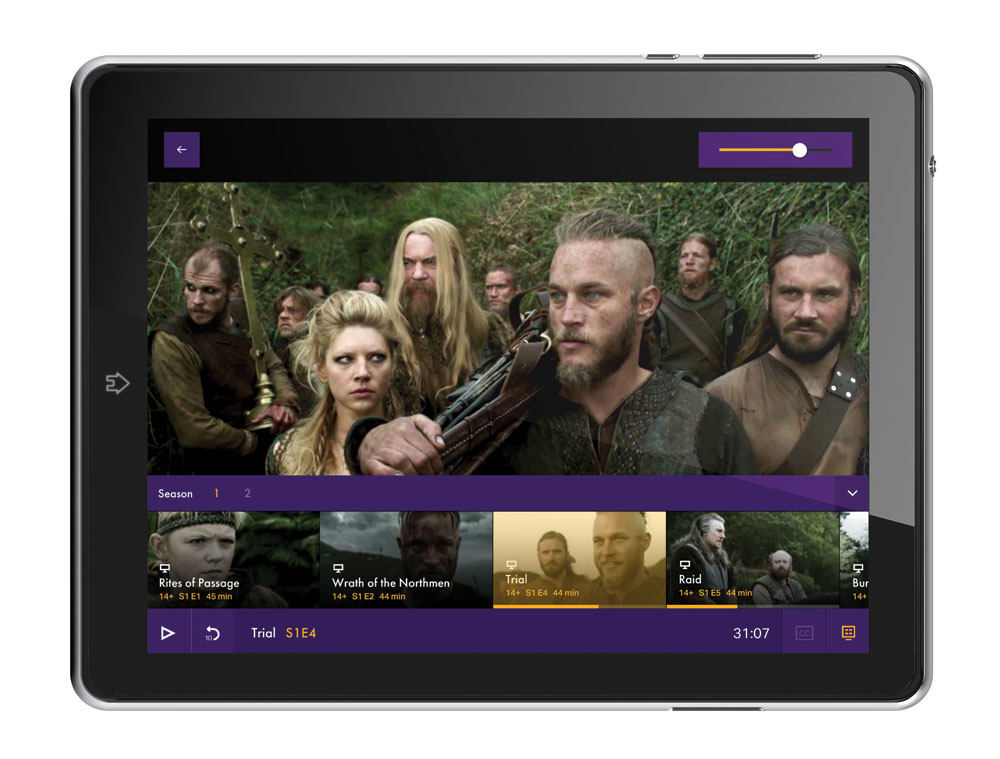
After more than 35 years of operation, TBI is closing its doors and our website will no longer be updated daily. Thank you for all of your support.
Curation: the new dark art
 Now that streaming platforms can build a much more accurate picture of their subscribers’ behaviour and use this data to deliver content tailored to their needs and tastes, curation has become all-important. Bob Jenkins reports
Now that streaming platforms can build a much more accurate picture of their subscribers’ behaviour and use this data to deliver content tailored to their needs and tastes, curation has become all-important. Bob Jenkins reports
“You can please some of the people all of the time and all of the people some of the time, but you can’t please all of the people all of the time”. Unless, that is, you work in OTT. The new medium’s ability to deliver what people want, when they want it, and on the device they want it, is one crucial difference, possibly the crucial difference, between streaming and its linear forbearer, already referred to by many as ‘legacy television’.
One key element in OTT’s ability to overturn the opening observation of John Lydgate (a 15th century English monk and poet from whom Lincoln pinched the observation) is the art known as ‘content curation’; not to be confused with linear TV’s famous dark art of scheduling.
This is the view of Jason Cosgrove, director of business development at digital prodco and MCN operator Defy Media. He is clear that “curation is something quite distinct from scheduling”. He adds: “With the proliferation of apps on mobile, tablets and OTT we are finding different audiences gather on different platforms looking for different experiences.
“For example when it comes to our Break app, we have both short form and long form content offerings,” he says.
“A mobile user isn’t necessarily looking to watch a feature film in the middle of the day, but that same user might visit our Roku app at the end of the day and join us to watch a movie. We’re curating what we put where and when we put it there, and, with the real-time data we are able to see [activity] on each platform and make timely programme changes in response.”
Sohail Anjum, digital marketing manager at UAE-based OTT service icflix agrees with Cosgrove that curating is important and that a reading of a users’ behaviour is a key element in that process. “Scheduling”, says Anjum, “refers to arranging or planning content, while curating is more about using professional or expert skills or knowledge to discover and select content that is relevant to your audience, and then organising and presenting it in a targeted way.”
 “You need to learn what people’s tastes are, and also to learn about their needs and preferences, and then tailor the content offering for them,” he adds. “Within each country in which we operate, we localise the content so that, as viewing habits change, we change along with them. This makes curating content a very important part of what we do at icflix”.
“You need to learn what people’s tastes are, and also to learn about their needs and preferences, and then tailor the content offering for them,” he adds. “Within each country in which we operate, we localise the content so that, as viewing habits change, we change along with them. This makes curating content a very important part of what we do at icflix”.
Don Klees, vice president, programming, at Acorn Media Group, says: “Curating content is not just an important part of what I do – it is what I do.” Klees accepts that while scheduling the presentation of new programming – or old favourites – can be useful in helping an audience to find their next favourite programme, the overall offer has to justify their time and attention, meaning “curating and scheduling are absolutely different things”.
Lesley MacKenzie is managing director of a leading German SVOD platform, Maxdome. She says there is an element of semantics in the distinctions between ‘curating’ and ‘scheduling’.
“While ‘scheduling’ is terminology and a mechanism of the linear TV world, which requires a sequential order of content to be aired following specific timings, ‘curating’ is instead about selecting content based on editorial decisions,” she says. “To this extent, both linear and OTT services may be said to be ‘curated’, while ‘scheduling’ is not necessary on an OTT service, as content is available everywhere and at any time”.
For those who built careers on their understanding of the art of scheduling, perhaps the really frightening thing about the new art of curating is that it is child’s play. Or, at least, that is the view of Canada’s SVOD service Shomi.
The streaming joint venture between Shaw Communications and Rogers Communications announced in March that, for one week only, it would be offering three different collections, all chosen, or curated, by the kids of the platform’s staff.
 The packages were for under fives, including titles such as Tuff Puppy, Blue’s Clues and Animal Mechanical. A second package for 6-9s included Johnny Test, Hotel Transylvania and Scooby Doo, while the third package for 10-13s, offered Batman, Boy Meets World and iCarly.
The packages were for under fives, including titles such as Tuff Puppy, Blue’s Clues and Animal Mechanical. A second package for 6-9s included Johnny Test, Hotel Transylvania and Scooby Doo, while the third package for 10-13s, offered Batman, Boy Meets World and iCarly.
Marni Shulman, Shomi’s head of content and programming says: “One of the things that sets us apart – and that I love most about my role here – is the human curation factor. We really wanted to walk the walk with that, so taking the lead from our own kids for these three special collections was an obvious choice.”
This curating experiment is especially interesting given that historically, the kids audience differed from that of other age groups as the people often making the viewing choices – the parents – are not part of the audience they are addressing.
 The importance of the role of content curation should not be underestimated, says Maxdome’s MacKenzie, noting there are different methods to accomplish the task. “There are a number of ways in which it can be done. Some services might choose to select content based on algorithms, but at Maxdome we combine editorial and market specific insights with analysis of viewing patterns to enable us to select the relevant content for our customers”.
The importance of the role of content curation should not be underestimated, says Maxdome’s MacKenzie, noting there are different methods to accomplish the task. “There are a number of ways in which it can be done. Some services might choose to select content based on algorithms, but at Maxdome we combine editorial and market specific insights with analysis of viewing patterns to enable us to select the relevant content for our customers”.
At the heart of the OTT curation challenge is how to guide users to the content they want to watch. This throws up some interesting comparisons between library content and the premium titles that command top dollar in the market.
 Acorn is a service that specialises in delivering the best of British content. Klees says: “Acorn not only offers viewers in North America the opportunity to stream many of their favourite programmes, but, more importantly, it also offers them the chance to discover classic shows, previously unavailable to audiences in the US and Canada”.
Acorn is a service that specialises in delivering the best of British content. Klees says: “Acorn not only offers viewers in North America the opportunity to stream many of their favourite programmes, but, more importantly, it also offers them the chance to discover classic shows, previously unavailable to audiences in the US and Canada”.
Klees makes a comparison between classic titles and newer programming. “An archival title is more likely to have proven itself a good fit – or not – for Acorn TV,” he adds. “A new title on the other hand, however highly touted, is always going to be a bit of a wild card. When you’re competing for new titles with other OTT services and broadcasters, you’re often placing large bets on unproven programming.”
For Defy’s Cosgrove there is a balancing act involved. “When we’re programming content we certainly do want to highlight what’s new and exciting, but, at the same time, we want users to have access to the videos that made them fall in love with our brand to begin with,” he says. “There certainly is a focus for us on showing what’s new from our brands, and you will certainly always find the newest episodes featured prominently. But in the case of Movies On Break, in one sense at least, the entire library is archive. Therefore, we are always curating that library to bring a fresh perspective to content people are already familiar with.”
 Success in the online environment is, then, not necessarily all about the biggest blockbusters. “In an on-demand world, a service not only needs to select relevant content, it also needs to present it in a way that provides editorial guidance to its users,” Maxdome’s MacKenzie says. “Our users make selections based both on the way in which the content is presented, and also on the environment in which it is presented. Thoughtful curation helps our users make a decision, in that critical moment and can drive attention to titles which are not necessarily blockbusters”.
Success in the online environment is, then, not necessarily all about the biggest blockbusters. “In an on-demand world, a service not only needs to select relevant content, it also needs to present it in a way that provides editorial guidance to its users,” Maxdome’s MacKenzie says. “Our users make selections based both on the way in which the content is presented, and also on the environment in which it is presented. Thoughtful curation helps our users make a decision, in that critical moment and can drive attention to titles which are not necessarily blockbusters”.
The need for curation to aid a user in the on-demand world is heightened when so many services, even those that are less well-known, have such a high volume of content on offer.
Reliance Majestic’s UK and North American on-demand platform CinemaNow has deals with all the major Hollywood studios, allowing it to offer over 30,000 movies, including new releases.
Donna Smith,VP, new business, says: “We also offer all the most recent TV hits from all the major broadcasters and producers including many classic boxed set series as well as documentaries from indie producers and small publishers, meaning that we currently offer a wider selection of TV than either HBO or Showtime”.
Even if the need for curation is created by the sheer quantity of content offered on platforms such as CinemaNow, it is clear that it is already much more than a digital library system.
 Curation is first and foremost the process of knowing what users of a service want, and when, and how they want it delivered. As the means of monitoring users’ behaviour grow more sophisticated, it is likely that the significance of curation on the SVOD business will grow.
Curation is first and foremost the process of knowing what users of a service want, and when, and how they want it delivered. As the means of monitoring users’ behaviour grow more sophisticated, it is likely that the significance of curation on the SVOD business will grow.
“It is too early, at this point, to say that curation goals are driving original programming and acquisition decisions,” Defy’s Cosgrove says, “but the learnings we are taking away from our curation efforts certainly are providing insight into what programming our audience gravitates towards, and that is informing future programming”.
For Acorn’s Klees it’s certainly not too early to make the connection. “Other than financial considerations, I am not sure that ‘curation’ and acquisitions policy’ can really be separated for Acorn TV,” he says.
Of course, broadcasters have always sought to monitor the popularity of content they offer, and to modify editorial decisions accordingly. There’s nothing new in that. What is new are both the accuracy of this information and its ability to be read in real time.


